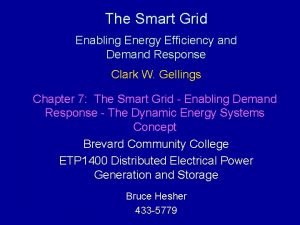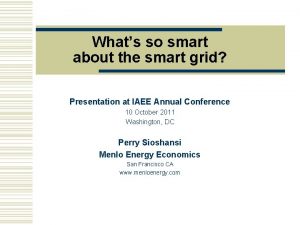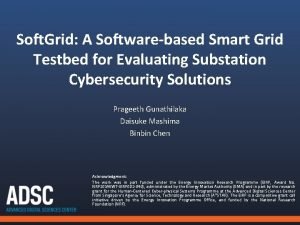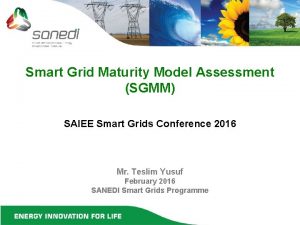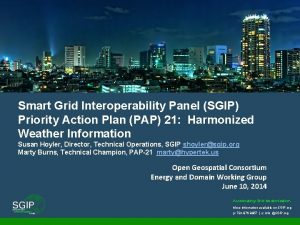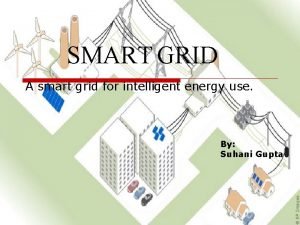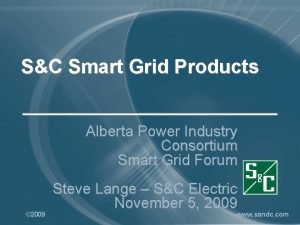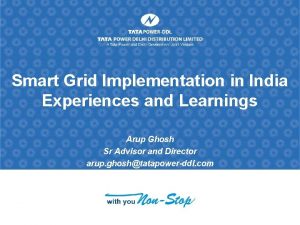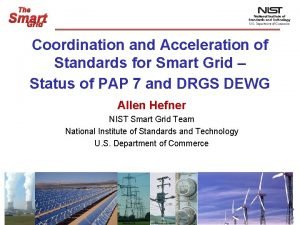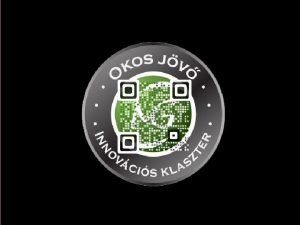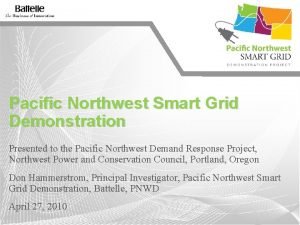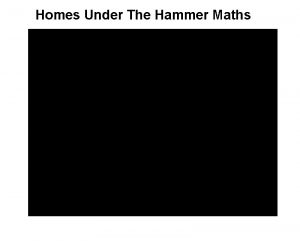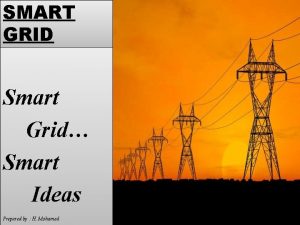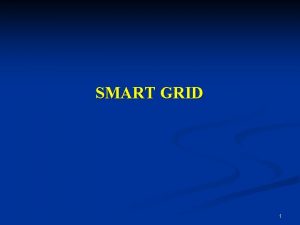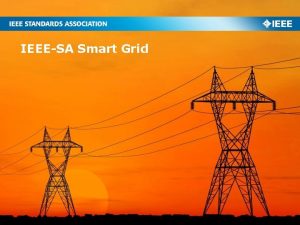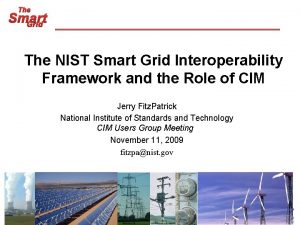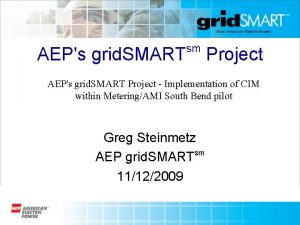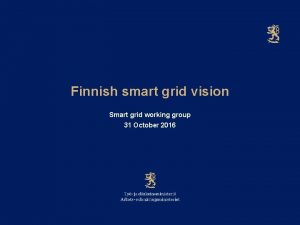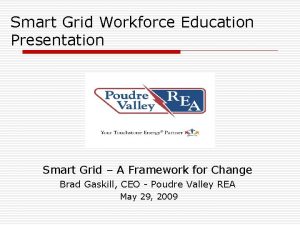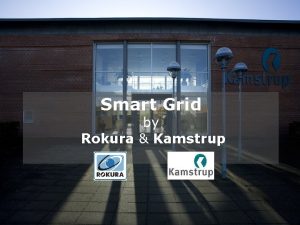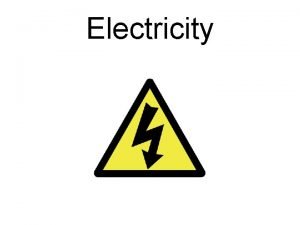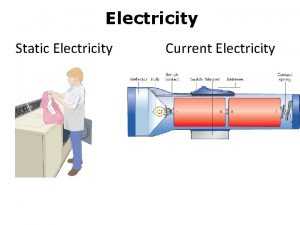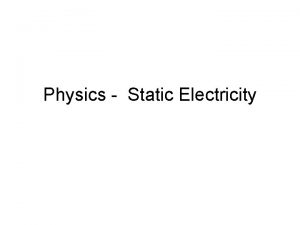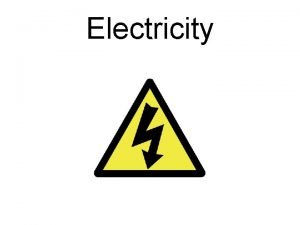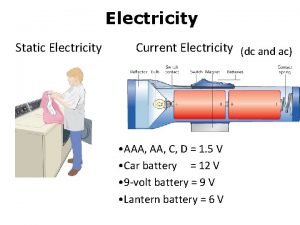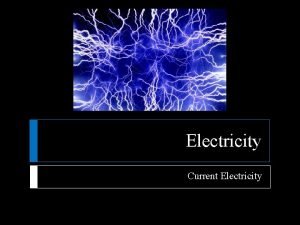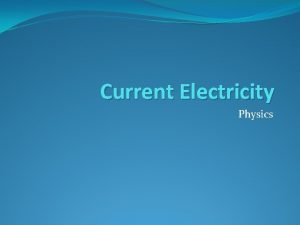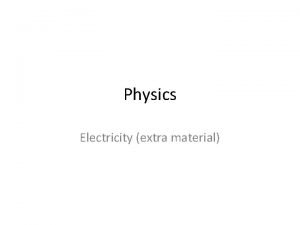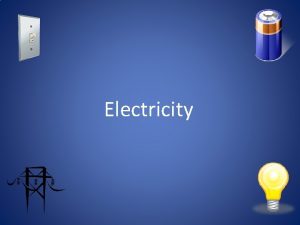Electricity Management for Smart Homes under Smart Grid


























































































- Slides: 90

Electricity Management for Smart Homes under Smart Grid Development George Jyh-Yih Hsu Professor Department of Management Information Systems Department of Applied Economics National Chung-Hsing University Taichung, Taiwan 2011/9/1 1

Outline 1. Introduction 2. Trends of Carbon Reduction and Energy Saving 3. Smart Grid and Electricity Management for Smart Homes in Taiwan, California and Hawaii - 3. 1 Taiwan - 3. 2 California - 3. 3 Hawaii - 3. 4 Comparison 4. Benefits and Costs of Electricity Management for Smart Homes 5. Conclusion 6. Appendix : Smart Energy Experience 2

1. INTRODUCTION 3

Introduction • The core concept of smart grid is its capability of keeping track of electricity flow in the power system by two-way digital technology that allows consumers to see how and when they use energy. • Smart grid is essential to – encouraging renewable energy deployment – transiting industries to low-carbon and clean-energy patterns – creating new “green jobs” for more employment – empowering customers to reduce their energy use and costs – building an infrastructure for long-term sustainable economic development 4

Introduction • There are many benefits of developing smart grid – – – – – enhancement of power supply reliability voltage service quality integration of transmission congestion relief advanced metering infrastructure (AMI) distributed energy resources (DER) battery energy storage system (BESS) usage of electric vehicles demand response (DR) outage response 5

Introduction • Today, policymakers and many utilities are focusing on how to accelerate the transition to a smart grid. Hawaii likewise is launching a smart grid demonstration project in Maui. • Electricity management for smart homes under smart grid development is a public policy concern. As a relatively small consumer, contrasting to large industrial customers, the benefit versus the cost of deploying new technologies for smart homes is sometimes questionable. • This presentation will address some of the key issues in relation to electricity management for smart homes with smart grid, which is partial research results of my NSC funded project and on-site research in California and Hawaii (scheduled 2011/8/9 to 2011/9/8). 6

2. TRENDS OF CARBON REDUCTION AND ENERGY SAVING 7

Carbon Footprint(1/2) Source : 2003 -2009 Global Footprint Network 8

Carbon Footprint(2/2) • The Carbon Footprint is 50 % of Humanity’s Overall Ecological Footprint and Its Most Rapidly-growing Component • Reducing Humanity’s Carbon Footprint is the Most Essential Step We Can Take to End Overshoot and Live on Earth. 9 Source : 2003 -2009 Global Footprint Network

Carbon Disclosure Project(1/3) • The Carbon Disclosure Project (CDP) is an independent not-for-profit organization which holds the largest database of corporate climate change information in the world. • Some international corporations demand their suppliers to report greenhouse gas emissions and have selected the Carbon Disclosure Project as the standard system for suppliers to report through. 10 Source: 2003 -2009 Global Footprint Network

Carbon Disclosure Project(2/3) 11 Source: Hong Yuan Lee (2011), Adaptation Strategy of Climate Change

Source: Hong Yuan Lee (2011), Adaptation Strategy of Climate Change 12

NZETS “Carbon would become the world’s biggest market. ” 13

Carbon Trading Price in EU Emissions Trading Scheme (EU ETS) 14

15 Source: http: //highscope. ch. ntu. edu. tw/wordpress/? p=26735

3. SMART GRID AND ELECTRICITY MANAGEMENT FOR SMART HOMES 3. 1 Taiwan 16

Smart Home Energy Management System 17 Source: Faa-Jeng Lin(2011), Strategic Initiatives of Smart Grid in Taiwan

ICT Frame of Smart Home(Building) Energy Management System 18 Source: Faa-Jeng Lin(2011), Strategic Initiatives of Smart Grid in Taiwan

Smart Home (Building) Energy Management Pilot Project Source : Faa-Jeng Lin(2011). Strategic Initiatives of Smart Grid in Taiwan 19

Overview of Taipower’s System Up to year 2010: • Peak Load: 33 GW • Customers: 12. 6 million • Total Generated Electricity (+IPP): 207. 4 billion KWh • Sale Electricity: 193. 3 billion KWh • Line Loss: 4. 66% Type nucle ar therm al hydro wind solar Total MW 5, 144 30, 71 7 4, 579 471 1 40, 91 2 % 12. 6 75. 1 11. 2 1. 1 0. 0 100 20

Taipower’s Vision on Smart Grid • Reliable Power Supply with High Power Quality • Productivity Improvement • Carbon Footprint • Communication, Information and Power Electronics Technology Improvement Create a high-quality, highefficiency, customer serviceoriented, and environmentfriendly power grid. Drivi ng Force s Smart. Gri d ICT Based n io Vis Ob jec ve ti • A higher safety and reliability of power network • Higher efficiency of power plants • Service-oriented system • Environment-friendly grid 21 Source: Faa-Jeng Lin(2011), Strategic Initiatives of Smart Grid in Taiwan

Taipower’s Smart Grid Roadmap Source: Faa-Jeng Lin(2011), Strategic Initiatives of Smart Grid in Taiwan 22

Overall AMI Architecture Meter Data Concent. Backhau l. Comm. Head. End Data Managmnt. Back Office External Source: Faa-Jeng Lin(2011), Strategic Initiatives of Smart Grid in Taiwan 23

Taipower High-Voltage AMI Timeline • On June 23, 2010, Executive Yuan Approved "AMI Development Program“. • High voltage AMI totaling 23, 300 meters covering 59% electricity consumption of Taiwan will be installed before 2012/12/31. Source : Faa – Jeng Lin(2011), Strategic Initiatives of Smart Grid in Taiwan 24

Objectives of Smart Grid and AMI Project (2010 -2013): • Complete the key technologies development of microgrid, AMI, advanced distribution automation, smart home (building) energy management pilot projects. • Complete the relevant regulations and standards of smart grid and AMI. • Hold a joint exhibition to demonstrate the developed key technologies. (2014 -2025): • Complete key technologies transformation and commercialization. • With the installation of AMI, complete the power management system of Taipower (such as time of usage and demand response). • Tying in with the transmission and distribution projects of Taiwan Power Company, promote the developed technologies of microgrid and advanced distribution automation gradually in Taipower system. • Promote comprehensively of smart home (building) energy 25 management technology. Source: Faa – Jeng Lin(2011), Strategic Initiatives of Smart Grid in Taiwan

TOU Rate for Residential Sector in Taiwan Residential customers have the option to switch from the traditional progressive pricing program to TOU rate , which are broken down into three periods: Peak, Partial Peak and Off Peak. 26 Source: Taiwan Power Company

Taipower’s Electric Basic Discount Rate Program • Starting from July 1, 2008, residential household, primary and secondary schools, and public facilities of communities are entitled to Electric Basic Discount Rate program. • The annual growth rate of the amount used is calculated within a billing cycle (2 months) compared to the same period of last year as follows: Growth rate of usage X(%)=(A-B)÷ B × 100% Where A=average usage per day (kwh) in a billing cycle B=average usage per day of the same month last year Electric Basic Discount Rate 27 Source: Taiwan Power Company

Taipower’s Incentive Discount for Counties Competition in Energy Saving Program • Apart from the incentive discount rate, there is another supplementary Incentive Discount for Counties Competition in Energy Saving. • The competition comprises of national 25 Counties and takes place every two months to be consistent with a billing cycle. • Again, the evaluation of the competition results is based on the growth rate of average usage per day (kwh) in a billing cycle of the household in the counties. Incentive Discount For Counties Competition In Energy Saving 28

2009 Taiwan National Energy Conference • CO 2 Reduction Target: 2016 -2020 Emission Level Equivalent to 2008 Base. (2007 Level Is 268 Million Tons) • Government New Targets – 2025 Emission Level Equivalent to 2000 Base – 2025 55% Low-Carbon Energy Supply – 2050 Equivalent to 50% 2000 Base • Implementing Energy Tax, Carbon Tax, Green Tax Reform, ETS (Emission Trade System) 29

3. SMART GRID AND ELECTRICITY MANAGEMENT FOR SMART HOMES 3. 2 California 30

California Smart Gird and AMI • As a first step toward a smarter grid, the CPUC beginning in 2006, authorized the state’s investor owned utilities (i. e. , PG&E, SDG&E, SCE) to replace conventional customer meters with advanced meters. • Advanced meters serve as a fundamental building block of the Smart Grid by providing customers with the ability to have greater control over their electricity usage. 31 Source: California Public Utilities Commission

Merging Two Infrastructures 32 Source: Electric Power Research Institute

2011 California Smart Meter Deployment • • PG&E 7. 1 million meters SCE 2 million meters SDG&E 1. 9 million meters Full deployment of advanced meters across the three IOUs service territories is expected to be completed during 2012. 33 Source: California Public Utilities Commission

Advanced Metering Infrastructure Deployment • To what extent can careful architecting of the California smart grid enable advanced metering accommodate standards protocols SCE Deployment (5. 3 M, $1. 7 B) infrastructure to flexibly future standards, protocols, and applications that are developed after AMI deployment is well underway? 34 Source: Electric Power Research Institute

Technology at Different Levels 35

Critical Technology Areas Identified 36

Critical Technology Areas and Gaps(1/5) • Architecture and communications infrastructure : to support interoperable field equipment, automation, and information exchange for the smart grid with standards, methods, and tools – Communications security – Requirements development specific to accommodating distributed resources and intermittent renewable resources in grid operations, requirements repository – Management Infrastructure – Communications media assessment (standards development status, appropriateness for applications) 37 Source: Electric Power Research Institute

Critical Technology Areas and Gaps(2/5) • Grid operations and control : to automatically monitor, assess, and control the grid to ensure power quality and reliability – Wide Area Measurement System – Substation Automation, Distribution Automation, Managed Islanding – Smart metering for augmenting distribution automation 38

Critical Technology Areas and Gaps(3/5) • Renewable and distributed energy resource integration : to integrate and manage new sources of renewable energy and distributed energy resources – Interconnection – Storage and power electronics for renewables and distributed generation – Wind integration in grid and market operations 39 Source: Electric Power Research Institute

Critical Technology Areas and Gaps(4/5) • Customer system : to enable customer to be active in electricity supply chain – Smart metering, home area network, communicating thermostat, plug-in hybrid electric vehicle – Integration of wholesale/retail electricity products, enabling technologies, and different rates structures to develop solutions that better meet customer needs 40

Critical Technology Areas and Gaps(5/5) • Asset and capital efficiency : to optimize system planning and improve asset throughput – “Urban planning” tools for power grid – Condition based monitoring • Workforce effectiveness : to maximize workforce productivity, effectiveness, and safety through application of enabling tools, technologies and training – Training, O&M processes 41 Source: Electric Power Research Institute

California Renewable Energy Development • According to Governor Jerry Brown, California will add 20 GW electricity from renewable resources with 12 GW localized electricity generation and 8 GW from large-scale renewable energy projects by 2020. • Governor Brown signed into law to require 33% energy be renewable by 2020. • SCE already had 19. 4% of electricity generated from renewable in 2011 which is among the highest ones over 3000 utilities in the U. S. 42

California Launches RAM to Procure 1 GW of Renewable Energy • The California Public Utilities Commission (CPUC) unanimously approved the RAM (Renewable Auction Mechanism) policy, which is quite different from FIT(Fit-In-Tariff) and RPS (Renewable Portfolio Standard), to encourage and streamline the development and procurement of renewable energy from projects in the 1 MW-20 MW size range. 2011 Capacity Allocation for RAM Procurement and Per Auction IOUs Total Program Capacity(MW) Per auction(MW) SCE 259. 4 65 PG&E 420. 9 105. 2 SDG&E 80. 7 20. 2 Total 761 190. 25 Source: California Public Utilities Commission, CPUC Source: CPUC Resolution 4414, P 56 43

3. SMART GRID AND ELECTRICITY MANAGEMENT FOR SMART HOMES 3. 3 Hawaii 44

Maui Smart Grid Project Overview • Maui Smart Grid Project is a demonstration project funded through U. S. Department of Energy (DOE), Renewable and Distributed Systems Integration (RDSI) program – RDSI is a R&D program focusing on grid integration of distributed energy resources • In 2007, the RDSI program issued an RFP for demonstration projects – HNEI-led team won one out of 9 awards - 80 applicants – Project total budget of $15 million from 2009 -2013 • $7 million DOE funds, $8 million cost share with partners 45 Source : HAWAII NATURE ENERGE INSTITUTE

Maui Smart Grid Project Objectives • Reduce distribution circuit peak loading by >15% – By demand response, switching peak loads to energy storage, and reducing voltage • Improve service quality – By using Integrated volt/var control, outage management • Enable consumers to manage their energy use to minimize electric bills – By using customer portals and advanced home energy gateways for a few homes • Support grid stability – Controllable loads, storage, and improved voltage/current information will improve grid stability • Enable greater utilization of as-available renewable energy sources – By providing measurement and estimation of distributed PV to 46 Source : HAWAII NATURE ENERGE INSTITUTE the utility operator

Project Located in Wailea, Maui 47 Source : HAWAII NATURE ENERGE INSTITUTE

Advanced Metering Infrastructure (AMI) Providing two-way communications to distribution system assets • AMI supports: – voltage monitoring – demand response – PV monitoring Wireless mesh network 48 Source : HAWAII NATURE ENERGE INSTITUTE

Demand Response Management System (DRMS) Manage load during system events and peak load • Load reduction during peak periods – Contribute to 15% peak load reduction • Increase energy consumption during off-peak hours – Increase energy production from renewable generation by shifting energy use from peak to off-peak hours 49 Source : HAWAII NATURE ENERGE INSTITUTE

Home Energy Management System (HEMS) Residential consumer portal • Monitor electricity usage & solar PV production • Programmable thermostat, load control switches, and “Gateway” • Demand response enabled comms for smart appliances • Communications: Supports Ethernet, Wi. Fi , Zigbee SEP 1. 0 • Interface: In-home display or web interface 50 Source : HAWAII NATURE ENERGE INSTITUTE

Battery Energy Storage System (BESS) Multiple Benefits • BESS located at Wailea Substation • Manage peak load – Discharge for 1 -2 hr during peak • Voltage regulation – Manage variability caused by load and PV • Renewables Integration – Non-spinning reserve rapidly inject power, and bridge to fast-start generation. – Reduce wind curtailment charge off peak during excess energy periods 51 Source : HAWAII NATURE ENERGE INSTITUTE

Maui Smart Grid Project Timeline 52 Source : HAWAII NATURE ENERGE INSTITUTE

Demonstrating New DMS Functions Home Energy Manager 53 Source : HAWAII NATURE ENERGE INSTITUTE

Maui Smart Grid Project Objectives Distributed Resources for Transmission-level Support Reduce peak load DMS ● ● Improve service quality ● ● ● Inform consumer decisions Grid stability Provide visibility to operator Improved outage mgmt Volt/VAR optimization ● ● ● ● Increase RE utilization Aggregate DER and provide dashboard control Volt/VAR control ● Visibility on PV output Aggregate DER and provide dashboard control Provide reserve support(potentially reduce reserves) AMI, DRMS, HEMS , and Monitoring Enable direct load control TOU price(in future) BESS ● Voltage monitoring validates DMS load flow Communicate prices Real-time display Energy mgmt system Can help manage voltage ● Real-time monitoring of PV Enable load control ● Load shifting ● ● Discharge energy to reduce load ● ● Discharge energy during system events Charge during off-peak 54 Source : HAWAII NATURE ENERGE INSTITUTE

Hawaiian Electric Company (island of Oahu) Rate Schedule Average cents per kilowatt hour (2010) Residential 25. 47 "P" Large power use businesses 20. 09 "J" Medium power use businesses 22. 27 "G" Smaller power use businesses 26. 87 "H" Commercial cooking, heating, air conditioning & refrigeration 22. 55 "F" Street and Park Lighting 23. 49 55 Sources: Hawaiian Electric Co.

Hawaii Electric Light Company (island of Hawaii) Rate Schedule Average cents per kilowatt hour (2010) Residential 36. 31 "P" Large power use businesses 29. 26 "J" Medium power use businesses 32. 27 "G" Smaller power use businesses 40. 29 "H" Commercial Cooking and Heating 33. 59 "F" Street and Park Lighting 33. 95 56 Sources: Hawaiian Electric Co.

Maui Electric Company (Maui County) Rate Schedule Maui Molokai Lanai Average cents per kilowatt hour (2010) Residential 29. 45 35. 78 37. 11 "P" Large power use businesses 26. 19 31. 52 35. 27 "J" Medium power use businesses 28. 83 36. 08 40. 22 "G" Smaller power use businesses 32. 39 44. 44 41. 38 "H" Commercial cooking, heating, air conditioning & refrigeration 29. 15 33. 96 36. 90 "F" Street and Park Lighting 27. 46 34. 27 36. 16 57 Sources: Hawaiian Electric Co.

HECO Energy Efficiency Program Energy Saving Results(from 1996 -2009) • Targeting residential and commercial sectors by providing rebates and other incentives • Reduce load demand by 169 MW • Avoided use of 1. 6 million barrels of oil annually • Reduced CO 2 by 864, 000 tons per year • Some of the programs’ highlights : – More than 1. 8 million compact fluorescent lights sold – More than 50, 000 solar water heaters installed – More than 39, 000 rebates issued for Energy Star appliances • Beginning July 1, 2009, SAIC replaced HECO to implement energy efficiency program in Hawaii state. Source: http: //www. renewablehawaii. com/portal/site/heco/menuitem. 508576 f 78 baa 14340 b 4 c 0610 c 510 b 1 ca/? vgnextoid=5294 bf 099 e 812210 Vgn. VCM 1000005 c 011 bac. RCRD&vgnextfmt=default&cpsextcurrchannel=1

Hawaii Clean Energy Initiative • Hawaii Clean Energy Initiative was signed between the State of Hawaii and the Hawaiian Electric companies in the chambers of Governor Linda Lingle on October 20, 2008 • In 2009, Hawaii State Legislature enacted this goal into law by establishing a renewable portfolio standard(RPS) of 40% and an energy efficiency standard of 30% by 2030 in Act 155. 59 Sources: Hawaiian Electric Co.

Mandated RPS and HECO’s Current Performance Year Mandated % From Renewable Energy Sources Hawaiian Electric RPS Exceeds Goal 2005 8% 11% 3% 2006 _ 13. 8% _ 2007 _ 16. 1% _ 2008 _ 18% _ 2009 _ 19% _ 2010 10% 20% 10. 7% Energy efficiency and solar water heating are no longer included in RPS 2015 15% _ _ 2020 25% _ _ 2030 Source: 2010 Corporate Sustainability Report , Hawaiian Electric Company, p 7 40% _ _ 60

Hawaii State Law Requirements Year 2010: 10 % of the company’s sales must be met by using renewable energy resources to generate electricity and energy savings brought about by technologies such as energy efficiency programs and solar water heaters. 61 Source: 2010 Corporate Sustainability Report , Hawaiian Electric Company, p 7

Hawaii State Law Requirements Year 2015 15 % of the company’s sales must be generated from renewable resources. The law establishes a separate Energy Efficiency Portfolio Standard, and therefore energy efficiency savings from solar water heating and energy efficiency technologies will no longer count toward the RPS. 62 Source: 2010 Corporate Sustainability Report , Hawaiian Electric Company, p 7

HECO’s Power Development Plan • HECO has planned to achieve 25%, 40% electricity generated from renewable in 2020 and 2030 respectively. • Estimated 300 MW new, firm generating capacity would be needed for HECO to replace lost capacity from 4 to be retired generating units and growing load demand, and solicitation for proposals is planned in 2011. 63

3. SMART GRID AND ELECTRICITY MANAGEMENT FOR SMART HOMES 3. 4 Comparison 64

Comparison of Per Capita Electricity Use in the US(HI & CA) and TW U. S. Per Capita Electricity Use by State in 2009 Rankin g State Population(thousands ) k. Wh(millions) k. Wh per capita 1 Wyoming 544 16, 556 30, 418 2 Kentucky 4, 314 88, 796 20, 583 3 North Dakota 647 12, 594 19, 470 33 United States 307, 007 3, 575, 450 11, 646 48 Hawaii 1, 295 10, 126 7, 818 49 Rhode Island 1, 053 7, 800 7, 406 50 New York 19, 541 139, 729 7, 150 51 California 36, 962 257, 275 6, 961 Sources:California Energy Commission Taiwan Per Capita Electricity Use in 2007 State Population(thousan ds) k. Wh(millions) k. Wh per capita Taiwan 22, 87 156, 000 6, 821 Sources:Taiwan Energy 65

2009 Average Residential Electric Rate Comparison Country Malaysia Mexico South Korea Taiwan Thailand America Hong Kong Norway New Zealand France Swiss Poland Finland AVG price per(US$)) 0. 0810 0. 0816 0. 0849 0. 0854 0. 1012 0. 1198 0. 1224 0. 1415 0. 1642 0. 1694 0. 1725 0. 1797 Country Singapore Philippines Czech Sweden Hungary England Portugal Japan Luxembourg Ireland Netherlands Italy Denmark AVG price per(US$) 0. 1871 0. 1919 0. 1983 0. 2004 0. 2128 0. 2221 0. 2355 0. 2448 0. 2634 0. 2665 0. 2933 0. 3770 Source : Taiwan power company (http: //www. taipower. com. tw/left_bar/Qn. A/electrical_bill_idea. htm) 66

Comparison between Taiwan and US • State-owned (Tai. Power) vs. IOUs(HECO, PG&E, SCE, SDG&E )---> implying legal/hearing process in US. • Monopolized (Taiwan) vs. liberalized or less regulated (US) electricity market. • Electricity demand structures: Taiwan (industrial sectors 52%) vs. US (industrial sectors 25%) • Vast lands (US) vs. island country (Taiwan) ---> implying relatively higher meter reading avoided costs in US. • Residual capital value of the depreciated grid and meters : Taiwan(relatively high) vs. US(relatively low) • Quite a few aged buildings in Hawaii and California have only one aggregate meter (US). 67

Comparison of Benefits and Costs of EMSH between Taiwan and US • Benefits(Avoided Costs): 1. Meter-reading manpower cost: relatively high (US). 2. Load shifts from peak to off-peak under TOU rates: US (potentially high, but diversified over various states) vs. Taiwan (relatively low and uniformed). 3. Incentives of electric rate by participating demand response program: US potentially higher than Taiwan. • Costs: Manpower cost for installing smart meter: US(relatively high) vs. Taiwan (relatively low). 68

4. BENEFITS AND COSTS OF ELECTRICITY MANAGEMENT FOR SMART HOMES 69

Different Approaches for Benefits Cost Ratio (BCR) There are various perspectives for BCR, including: • Participant Cost Test (PCT) • Program Administrator Cost Test (PAC) • Ratepayer Impact Measure (RIM) • Total Resource Cost Test (TRC) • Societal Cost Test (SCT) 70

Participant Cost Test Perspective of the Participating Customer Benefits Costs • Incentive payments • Incremental • Bill saving realized equipment costs • Applicable tax credits • Incremental or incentives installation costs 71 Source : Standard Practice Manual : Economic Analysis of Demand-Side programs and Projects

Program Administrator Cost Test Perspective of Utility, Government Agency, or Third Party Implementing the Program Benefits • Energy-related costs avoided by the utility • Capacity-related costs avoided by the utility, including generation, transmission, and distribution Costs • Program overhead costs • Utility/program administrator incentive costs • Utility/program administrator installation costs Source : Standard Practice Manual : Economic Analysis of Demand-Side programs and Projects 72

Ratepayer Impact Measure Perspective of : Would Rates Need to Increase? Benefits • Energy-related costs avoided by the utility • Capacity-related costs avoided by the utility, including generation, transmission, and distribution Costs • Program overhead costs • Utility/program administrator incentive costs • Lost revenue due to reduced energy bills 73 Source : Standard Practice Manual: Economic Analysis of Demand-Side programs and Projects

Total Resource Cost Test Perspective of All Utility Customers(Participants and Non. Participants) in the Utility Service Territory Benefits • • • Energy-related costs avoided by the • • utility Capacity-related costs avoided by the • utility , including generation, transmission, and distribution Additional resource saving(e. g. , gas and water if utility is electric) Monetized environmental and nonenergy benefits Applicable tax credits Costs Program overhead costs Program installation costs Incremental measure costs(whether paid by the customer or the utility) 74 Source : Standard Practice Manual: Economic Analysis of Demand-Side programs and Projects

Societal Cost Test Perspective of All in the Service Territory , State, or Nation as a Whole Benefits • Energy-related costs avoided by the • utility • • Capacity-related costs avoided by • the utility , including generation , transmission , and distribution • Additional resource saving( e. g. , gas and water if utility is electric) • Non-monetized benefits(and costs) such as cleaner air or health impacts Costs Program overhead costs Program installation costs Incremental measure costs(whether paid by the customer or the utility) 75 Source : Standard Practice Manual : Economic Analysis of Demand-Side programs and Projects

5. CONCLUSION 76

Conclusion(1/5) • The role of utility: from WEB 1. 0 to WEB 2. 0 • Taiwan advantage: from IT (Information Technology) country to ET (Energy Technology) country. • Green IT---> EMSH(Electricity/Energy Management for Smart Homes • EICT (Energy Information Communication Technology ) ---> EMSH 77

Conclusion(2/5) • The smart grid will link electricity with communications and computer control to create a highly automated, responsive, and resilient power delivery system that will both optimize service and empower customers to make informed energy decisions. • With smart grid providing coordination between the renewable generation and storage on the power system and demand response for customer loads, greater use of local renewable electricity generation is practical. 78

Conclusion(3/5) • With improved forecasting tools, the grid operators will have better information about resource variability and can make more informed dispatch decisions to maintain system reliability. • Architecture is key to integrate the different aspects of the smart grid. • A collaborative effort among all the stakeholders is needed to develop a smart grid vision. 79

Conclusion(4/5) • Storage technologies can be applied on the transmission and distribution system to regulate intermittency from renewable output and maintain system voltages at reliable levels. • Demand response can ease the integration of renewable by curtailing consumers’ electricity use to cope with instability of renewable generation. • Combining demand response with electric energy storage in a system enhances the value and capabilities of both measures. 80

Conclusion(5/5) • Customer choice is imperative as needs vary across customer classes with diverse preferences. • Customers can better manage their energy needs, and education is needed to understand application benefits and costs, and ways to capture value. • Education, demonstration, and customer awareness and acceptance are the keys to a successful Smart Grid and EMSH. 81

APPENDIX : SMART ENERGY EXPERIENCE 82

83

84

85

86

87

88

89

THANK YOU FOR YOUR ATTENTION Q & A 90
 Static electricity and current electricity
Static electricity and current electricity Current electricity gif
Current electricity gif Magnetism vocabulary
Magnetism vocabulary Smart grid enables distributed energy management
Smart grid enables distributed energy management Lga pin
Lga pin Brattle group
Brattle group Smart grid soft
Smart grid soft Sgmm
Sgmm Smart grid interoperability panel
Smart grid interoperability panel A smart grid for intelligent energy use
A smart grid for intelligent energy use Smart grid architecture model
Smart grid architecture model Intelliteam smart grid
Intelliteam smart grid Smart grid maturity model
Smart grid maturity model Conclusion of smart home system
Conclusion of smart home system Smart grid interoperability panel
Smart grid interoperability panel Solutii smart grid
Solutii smart grid Smart grid maturity model
Smart grid maturity model Pacific northwest smart grid demonstration project
Pacific northwest smart grid demonstration project Smart grid meaning in tamil
Smart grid meaning in tamil Kontinuitetshantering
Kontinuitetshantering Novell typiska drag
Novell typiska drag Nationell inriktning för artificiell intelligens
Nationell inriktning för artificiell intelligens Returpilarna
Returpilarna Varför kallas perioden 1918-1939 för mellankrigstiden?
Varför kallas perioden 1918-1939 för mellankrigstiden? En lathund för arbete med kontinuitetshantering
En lathund för arbete med kontinuitetshantering Adressändring ideell förening
Adressändring ideell förening Tidbok för yrkesförare
Tidbok för yrkesförare Sura för anatom
Sura för anatom Förklara densitet för barn
Förklara densitet för barn Datorkunskap för nybörjare
Datorkunskap för nybörjare Stig kerman
Stig kerman Debattartikel mall
Debattartikel mall Autokratiskt ledarskap
Autokratiskt ledarskap Nyckelkompetenser för livslångt lärande
Nyckelkompetenser för livslångt lärande Påbyggnader för flakfordon
Påbyggnader för flakfordon Vätsketryck formel
Vätsketryck formel Offentlig förvaltning
Offentlig förvaltning Jag har nigit för nymånens skära text
Jag har nigit för nymånens skära text Presentera för publik crossboss
Presentera för publik crossboss Teckenspråk minoritetsspråk argument
Teckenspråk minoritetsspråk argument Bat mitza
Bat mitza Klassificeringsstruktur för kommunala verksamheter
Klassificeringsstruktur för kommunala verksamheter Mjälthilus
Mjälthilus Bästa kameran för astrofoto
Bästa kameran för astrofoto Centrum för kunskap och säkerhet
Centrum för kunskap och säkerhet Lågenergihus nyproduktion
Lågenergihus nyproduktion Mat för unga idrottare
Mat för unga idrottare Verktyg för automatisering av utbetalningar
Verktyg för automatisering av utbetalningar Rutin för avvikelsehantering
Rutin för avvikelsehantering Smärtskolan kunskap för livet
Smärtskolan kunskap för livet Ministerstyre för och nackdelar
Ministerstyre för och nackdelar Tack för att ni har lyssnat
Tack för att ni har lyssnat Vad är referatmarkeringar
Vad är referatmarkeringar Redogör för vad psykologi är
Redogör för vad psykologi är Stål för stötfångarsystem
Stål för stötfångarsystem Tack för att ni har lyssnat
Tack för att ni har lyssnat Borra hål för knoppar
Borra hål för knoppar Vilken grundregel finns det för tronföljden i sverige?
Vilken grundregel finns det för tronföljden i sverige? Relativ standardavvikelse formel
Relativ standardavvikelse formel Tack för att ni har lyssnat
Tack för att ni har lyssnat Rita perspektiv
Rita perspektiv Ledningssystem för verksamhetsinformation
Ledningssystem för verksamhetsinformation Tobinskatten för och nackdelar
Tobinskatten för och nackdelar Toppslätskivling effekt
Toppslätskivling effekt Modell för handledningsprocess
Modell för handledningsprocess Egg för emanuel
Egg för emanuel Elektronik för barn
Elektronik för barn Fredsgudinna pax
Fredsgudinna pax Strategi för svensk viltförvaltning
Strategi för svensk viltförvaltning Kung som dog 1611
Kung som dog 1611 Humanitr
Humanitr Ro i rom pax
Ro i rom pax Tack för att ni lyssnade
Tack för att ni lyssnade Enheter för massa
Enheter för massa Vad är prosa
Vad är prosa Inköpsprocessen steg för steg
Inköpsprocessen steg för steg Rbk mätning
Rbk mätning Ledarskapsteorier
Ledarskapsteorier Exspektans eller expektans
Exspektans eller expektans Myndigheten för delaktighet
Myndigheten för delaktighet Trög för kemist
Trög för kemist Tillitsbaserad ledning
Tillitsbaserad ledning Läkarutlåtande för livränta
Läkarutlåtande för livränta Karttecken
Karttecken Geometri för barn
Geometri för barn Texter för hinduer tantra
Texter för hinduer tantra Vad är vanlig celldelning
Vad är vanlig celldelning Bris för vuxna
Bris för vuxna Jätte råtta
Jätte råtta Book smarts vs street smarts
Book smarts vs street smarts One smart man he felt smart
One smart man he felt smart



